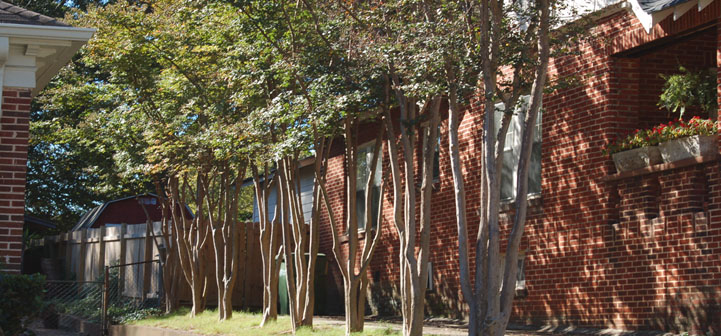Reviewed and Revised on 10/17/2013
In hot, humid climates, home designs should aim to reduce summer heat gain as the first priority. Walls facing east and west receive the greatest amount of heat, because they receive the direct morning and afternoon sunlight. Some of that heat is transferred (through conduction, convection, and radiation) into the home, which means your air conditioner has to operate longer and harder. It’s much more energy efficient to stop the heat from entering your home in the first place, rather than trying to cool down a too-hot interior.
The sun warms your home in three ways:
-
by direct radiation
-
by reflected radiation from patios, driveways, or other buildings
-
by re-emitted radiation from concrete, asphalt, and brick
When looking at the areas that need to be shaded, consider all these sources of heat.
Where should you place shade?
In order for shade trees and other plants to be effective in reducing your energy bills, they must be planted in the right places. The first target area for shading should be the windows and glass doors in the walls facing west, east, and south. Here’s why: one square foot of unshaded west-facing glass can admit as much heat as 15–30 square feet of wall, depending on how well the wall is insulated.
To keep your home cooler, plan landscapes that keep the sun away from the east and west sides of your house. Plants that cast shadows over east- and west-facing walls during the summer can greatly reduce the heat load on the home. The U.S. Department of Energy (DOE) estimates that “shading your home can reduce indoor temperatures by as much as 20ºF.” Trees, shrubs, and vines can all be used to shade walls and windows, and properly placed tall trees will cast shadows over the roof of a typical single family home. There’s more to this cooling effect than simple shading. Plants release large amounts of water from pores in their leaves, and the evaporative cooling which results from this release creates a zone of cool air around the plant—as much as 9ºF cooler. You can take advantage of this effect by using plants for shade and wind control rather than structures such as fences or arbors.
What should you consider?
When planting shade trees, keep in mind things like the mature height of the tree, the shape of the shade canopy, and the height of the home. This can influence how far from the house you plant a tree; trees planted closer to a wall shade it for a greater portion of the day, and for a greater part of the summer. Research has shown that the shadow of a tree planted 10 feet from the home moves across the “target surface” 4 times slower than one planted 20 feet from the home, which means the shading benefit will be greater.
Also keep in mind the type of shade cast by different species. Broad-leaf evergreens such as Southern magnolia provide dense year-round shade. Needle-leafed evergreens (pines, cedars, and junipers) cast a more sparse and open shade—which may be preferable where both shade and air circulation are important factors.
And if you’re unable to use trees to shade your home? Shrubs and vines can be used effectively as well. Shrubs trained to grow against a wall can block significant amounts of sunlight from reaching and heating up the wall. Or consider vines. Self-supporting vines (such as Virginia creeper) can be used on brick or concrete block homes to protect walls from the heat of the sun; they are not recommended for use on wood homes because they may trap moisture that can cause decay or potential pest problems. Twining vines such as Confederate jasmine need the support provided by a trellis. You can place trellises to provide shade and air circulation wherever they’re needed (e.g. near walls, windows, or outdoor living spaces). If possible, use vines that lose their leaves in winter for southern exposures, so that you can take advantage of winter sunlight to heat the home.
Trees and shrubs aren’t the only things that create a cool “microclimate” in their immediate vicinity. Grasses and ground covers can also help reduce the amount of heat gain around a home. The U.S. Department of Energy (DOE) found that a grass-covered lawn is usually 10ºF cooler than bare ground in the summer. Clearly it’s a “cool” idea to use properly placed grass and ground covers as much as possible, rather than asphalt or concrete. And if you choose ground covers suitable to your soil and moisture conditions, you won’t need to mow, water, or fertilize them as often—or even at all, depending on the species—saving even more energy.
What about the air conditioner?
And don’t forget your air conditioning unit! A unit in direct sunshine uses more energy than a unit in a shady area. Shade-casting plants keep the air around the conditioner cooler, so that it doesn’t have to work as hard. Make sure, however, that leaves and branches don’t block the unit’s airflow. If warm discharge air can’t escape, then the temperature of the intake air rises and the air conditioner won’t operate as efficiently. Place plants so they cast shade without blocking airflow. Clear off any leaves that fall on the unit’s outside coils as well. Direct the condensation overflow pipes away from the building to reduce moisture buildup.
Summary
All this can make a real difference to your energy bill. Carefully positioned trees and other plants can save up to 25% of a typical household’s energy for heating and cooling. The US DOE predicts that just three properly-placed trees can save an average household between $100-$250 in heating and cooling energy costs annually. And in winter, homes in some areas can receive the free benefits of solar heating by planting deciduous trees (those that shed all or most of their leaves each year) on the south side of the home.
